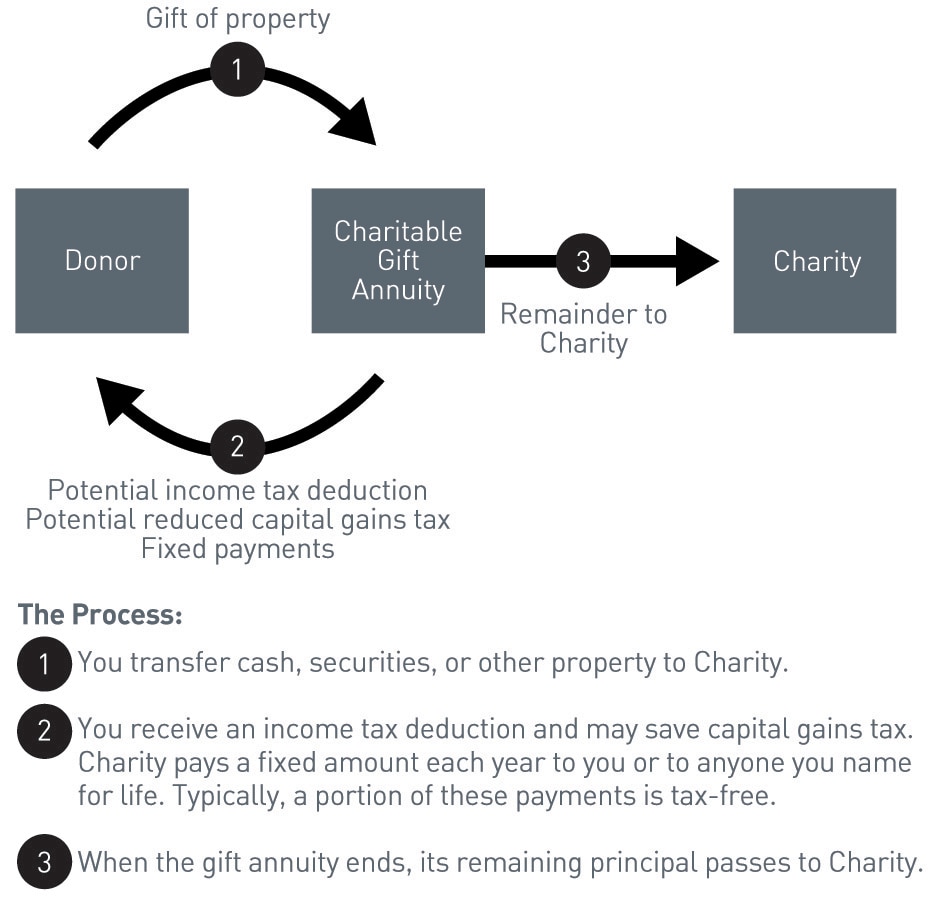
Views from PNC’s Planned Giving Team
While charitable gift annuities (CGAs) are often a small portion of a charity’s assets, they can pose investing challenges due to their differences from other types of assets, such as a charity’s long-term asset type like endowments. When determining the appropriate asset allocation, these differences are key considerations.
Endowments are permanent funds providing support to the charity in perpetuity; a CGA is a contract under which a charity, in return for a transfer of assets (cash, marketable securities or other assets), agrees to pay a fixed amount of money to one or two individuals for their lifetime. The contract nature of CGAs removes some of the flexibility endowment funds have in terms of spending. With a CGA, the charity is obligated to make the fixed payments on the frequency which is set out in the initial contract.
Investment Objective
One of the biggest differences between CGAs and endowments is the investment objective of the assets. Endowments must balance the need of current and future beneficiaries. This balance leads to an investment objective of preserving the purchasing power of the assets at a minimum which equates to the endowment’s spending rate plus inflation. For example, if the endowment has a 4% spending policy and inflation is 2%, the investment objective should be 6% to preserve the purchasing power of the assets.
A CGA is a contract between the donor and a charity. In exchange for the donor’s irrevocable gift of cash, securities, or other assets, the charity agrees to pay one or two annuitants a fixed sum each year for life. Upon the death of the annuitants, the remainder will go to the charity. A vast majority of charities use the American Council on Gift Annuities (ACGA) table of suggested CGA rates. A key assumption in these rates is CGAs have an expected target residuum (remaining balance left to the charity) of 50% of the original gift value.

Source: PG Calc, Considerations for Charitable Gift Annuity Assets; PNC
View accessible version of this infographic.
The assumption that the original gift amount will be reduced over the life of the CGA typically leads to lower expected investment returns. Currently, ACGA has a gross (before expenses) investment return assumption of 3.75% effective July 1, 2020. Of course, each gift will have its own experience influenced by the beneficiary’s longevity and investment returns during the gift’s life.
Time Horizon
As permanent funds, endowments have a time horizon in perpetuity while CGAs have a much shorter time horizon based on donors’ life expectancy, often 10-12 years. While we have seen in some of our clients a tilt toward longer time horizons as they market to younger donors, average life expectancies still hover around 12 years, based on Institutional Asset Management® analysis of planned giving clients. This may not necessarily be a short time period, but there is less time for recovery versus a time horizon without end.
Payout Rate
Another characteristic of CGAs is the higher, fixed payout amount versus an endowment spending policy. Endowments often have a fixed payout rate of 4-6% of market value, allowing the payout amount to fluctuate with the market value. CGAs instead pay out a fixed dollar amount regardless of the current market value.
Based on the 2021 ACGA survey, the average age of an annuitant when he or she makes a gift is 79. Using rates effective January 1, 2024, a 79-year-old donor would receive 7.8%, the initial gift amount annually1. For example, if the donor establishes a CGA with a gift of $10,000, the income beneficiary would receive $780 per year (based on ACGA suggested rates) for the rest of his or her life regardless of whether the market value stays at $10,000 or moves up or down. Additionally, it is common to have market values decrease over time since the ACGA targets a 50% residuum, leading to the actual payout rate (annual annuity/current market value) increasing over time. This higher, fixed payout rate leads to market values that are more susceptible to marked declines when confronted with volatility. As a result, timing and volatility matter with CGAs more so than other types of assets that provide for a lower, variable payout amount.
Regulatory Constraints
Finally, CGAs may fall under much stricter regulatory constraints than endowments. Many states have state-specific regulations for CGAs; a helpful guide on specific state regulations can be found on the ACGA website,[2] which details each state’s stance on regulation. While there are some states that are silent on the issue and others that require only an initial notification on the issuance of CGAs, a small number require additional regulation with at least an initial registration with the state. For those states with a higher level of regulation, it is common for them to require a dedicated gift annuity reserve account and many require annual reporting on that reserve account. Fortunately, most states have gone the direction of the Prudent Investor standard for the investment of the CGA reserve account, but California and Florida still have investment restrictions that limit equities to a maximum of 50% in the reserve account. Additionally, while many states will “look through” underlying funds, California does not and requires the fixed income portion of the reserve to be invested in individual bonds, according to the ACGA.
Summary
The unique characteristics of CGAs require a mindful approach to setting appropriate asset allocation targets for each CGA program. To quote from the ACGA Best Practices introduced at the 28th Conference on Gift Annuities, “Reserve assets should generally be invested more conservatively than the general endowment and should remain more liquid than the general endowment.”
For more information, please reach out to your PNC representative.
ACCESSIBLE VERSION OF INFOGRAPHIC
The Process:
1. You transfer cash, securities or other property to Charity.
2. You receive an income tax deduction and may save capital gains tax. Charity pays a fixed amount each year to you or to anyone you name for life. Typically, a portion of these payments is tax-free.
3. When the gift annuity ends, its remaining principal passes to Charity.




